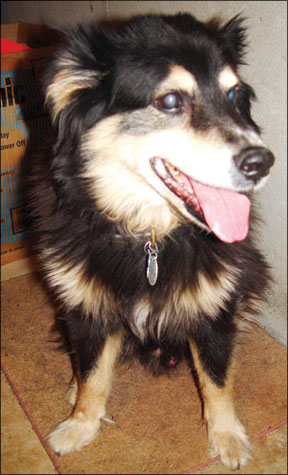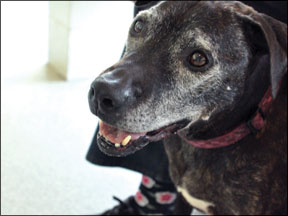Aaron Epstein’s 14-year-old Australian Shepherd-mix, Sam, was losing weight and his appetite wasn’t the same. “I just thought he was getting old because in addition to not eating with the same vigor, he was slowing down a bit, wasn’t able to walk as far, and sleeping a little too much,” Epstein recalls. The once 45-pound dog had shed close to 15 pounds -30 percent of his body weight -before concerned friends could convince a reluctant Epstein to get Sam to the veterinarian for an exam and blood work, both long overdue.
At the clinic, Sam was found to have an enormous mass growing on his spleen. The pressure from the mass made eating physically uncomfortable for Sam. Epstein followed the veterinarian’s recommendation and opted to have Sam’s spleen removed, as well as a number of other small tumors around his pancreas. Sadly, the veterinarian also discovered that the cancer was malignant. Although the prognosis for Sam was limited, he was home a few days later, eating like a horse and acting more like his formerly happy-go-lucky self.
From roughly age seven years on, a dog is considered senior, or geriatric, and it’s important that owners realize that old age is not a disease! If your elderly dog is losing weight, drinking and urinating more than he used to, can’t walk as far as he once did, or is exhibiting other changes in behavior, he’s not “just getting old” -he’s not well! Changes in our elderly dog friends are usually indicators of early chronic disease.

Aging is a natural process that is the result of the net effect of negative changes in physiology over time. In a chapter of Geriatrics and Gerontology of the Dog and Cat, William Fortney, DVM, writes, “A common characteristic of aging body systems is progressive and irreversible change. The effects of disease, stress, malnutrition, lack of exercise, genetics, and environment may hasten this change.”
There are common metabolic and physical effects of aging, but these should not be confused with chronic disease. Older dogs can be expected to experience a decreased metabolic rate, decreased immune competence and greater susceptibility to infection, and reduced thermoregulation. In addition, each organ system undergoes changes as dogs age.
Natural physical changes to dogs that occur with age include:
• Digestive system: Gastric mucosa atrophies, hepatocyte (liver cell) numbers decrease.
• Endocrine system: Pancreatic enzyme secretion decreases, hyperplasia of pituitary or adrenal glands.
• Integument: Skin becomes inelastic, footpads hyperkeratinize (get thicker), claws become brittle, muzzle grays.
• Cardiovascular system: Lungs lose elasticity, vital capacity (volume) decreases, cough reflex and expiratory capacity decrease, cardiac output decreases.
• Genitourinary system: Kidney weight decreases, prostate gland enlarges, testes atrophy (intact dogs), prepuce becomes pendulous.
• Musculoskeletal system: percent of body weight represented by fat increases; muscle, bone, and cartilage mass are lost; bones become brittle; bone marrow becomes fatty and hypoplastic.
• Nervous system: number of cells decreases; reduced reaction to stimuli; altered memory; diminished visual acuity, hearing, taste perception, and smell.
Although it is possible that one of these effects might lead to deterioration in body function, each alone is simply a result of the natural aging process. It’s when one or more of these changes progresses that we begin to see chronic disease. If even one of these changes occurs in your dog, it’s worth mentioning to your dog’s veterinarian to confirm whether it’s a normal aging change, or a preliminary sign of disease.
You are Your Dog’s Sole Caretaker
“It’s easy to list the common signs that indicate a potential problem, such as loss of appetite, increased drinking or urination, unusual bumps or discharges, vomiting or diarrhea, constipation, and lethargy/depression,” says holistic veterinarian Susan Wynn, DVM, CVA, CVCH, RH, of Georgia Veterinary Specialists in Atlanta. “But I find that owners frequently miss two of the more common problems. A ‘loss of appetite’ can be total or partial, but if it’s a partial loss, most owners tend to think their dogs have become ‘picky.’ Many people will try to get their ‘picky’ dogs to eat better for months while the disease process that caused the appetite change goes on unabated. This is an important message: If your dog has eaten well all of his life and suddenly becomes picky, this is a danger sign.
“The other thing that many owners miss is weight loss. If you think your dog has inadvertently lost weight, make a veterinary appointment now, because it means something went awry weeks to months ago.”
We need to do our part at home to notice changes in our canine friends. But don’t discount the expertise that your dog’s veterinarian can offer. Even when we don’t suspect a problem, geriatric wellness exams once (or even better, twice a year) are important. Start this practice (if you haven’t already) when your dog is about age seven. Regular senior wellness checks, complete with full blood work and urinalysis, and examination of your dog’s liver and kidney values, can be helpful in catching disease early.
“Because people see their dogs every day, sometimes they don’t see changes in those dogs. Getting a dog in for an exam twice -or even once -a year can uncover problems,” says Nick Berryessa, DVM, DACVIM, who also practices at Georgia Veterinary Specialists in Atlanta. “Put the dog on the scale, for example, and maybe we’ll see that he’s lost 10 pounds since last year. That’s a significant amount, even if it’s a 100-pound dog. If a person lost 10 percent of his body weight without changing his diet or exercise, it would be a red flag.”
What Goes Wrong with Elderly Dogs
The geriatric dog can develop multi-factorial problems; with an exam, you might be able to see why your dog is eating less, for example. Perhaps his teeth hurt and he has arthritis, both issues that should be individually investigated.
Dr. Berryessa outlined a few of the more common diseases that might be found in our geriatric dogs. Please note that each one, however, can be caused by a number of different disease processes.
Osteoarthritis
Leading the pack is osteoarthritis, especially in larger dogs and dogs who are overweight. One of the most important things we can do to ward off joint problems is to keep our dogs on the thin side; doing so has been proven to extend life expectancy. Nevertheless, with age can come signs such as lameness or slowing down that tell us that joint trouble is setting in. Ask your veterinarian to evaluate your dog and feel his joints, looking for pain in the joints, and consider x-rays to definitively pinpoint the problem.
From there, come up with a holistic plan to add the proper supplements, modalities such as massage and acupuncture, and, if necessary, prescription pain medication to give your dog relief. Dr. Wynn’s hierarchy of interventions for dealing with arthritis pain, and problems secondary to arthritis pain, starts with the basics such as glucosamine/chondroitin and fish oil. Then she suggests advancing, step by step, to include a more powerful glucosamine-type supplement (such as Thorne Research’s Arthroplex); massage; acupuncture; chiropractic; anti-inflammatory and analgesic herbs; shockwave, laser, or stem cell therapy; and non-steroidal anti-inflammatories (NSAIDs) or other prescription pain medications.
Chronic Kidney Disease
The cause of chronic kidney disease is not always known. Over time, the kidneys lose their ability to do their job, which is to eliminate waste from the body. Left unchecked, kidney disease can lead to other problems. One of the first signs of impaired kidney function is increased water intake and output of urine. At the point that the dog becomes unable to concentrate his urine, about two-thirds of his kidney function has already been lost. It’s important to provide a dog with kidney disease with ample fresh water and keep him hydrated. Diet also plays a role in managing this condition.
Urinalysis and blood tests conducted during an annual exam for Cathy Maher’s 14-year-old Lhasa Apso-mix, Dakota, in May 2007 indicated chronic kidney disease. Only a month earlier, Dakota had been diagnosed with mitral regurgitation (chronic mitral valve disease) after experiencing bouts of reverse sneezing, decreased appetite, increased lethargy, and a heart murmur. When the kidney disease was discovered, Dakota had no obvious symptoms other than some periodic decreased appetite and lethargy; these signs would have been easy to attribute to the mitral valve disease, had Cathy and her vet not been paying attention.
Dakota’s veterinarian felt that the chronic kidney disease was the bigger of the two issues for Dakota, and if they were able to get it under control, Dakota could have a quality life for two or three more years. Cathy was disheartened because she knew the condition, although treatable, was not curable. But she and her husband were committed to ensuring that they did everything they could to support Dakota’s quality of life.
They changed Dakota’s food, began fluid administration as needed at the vet, Calcitriol therapy, and a Vetri-Science Renal Essentials supplement in addition to continuing other supplements that he was already taking. With the intervention, careful treatment plan, and what Cathy describes as a fantastic veterinary team, Dakota did go on to live a high quality life for two more years, nearly reaching the 17 year mark.
Hypothyroidism
An underactive thyroid might reveal itself in a dog who has average, or even decreased, appetite, but in spite of that, is gaining weight. Weight gain despite level feeding is often the primary sign of hypothyroidism, but a poor hair coat or loss of energy may also be seen. A full thyroid panel can identify the disorder, and with the proper level of thyroid supplementation and periodic re-testing, your pal should be back on track in no time. Because the thyroid gland regulates metabolism of all body cellular functions, left untreated, hypothyroidism can lead to a significantly decreased quality of life for your pet. In most cases, the untreated condition will progress over months and years to result eventually in end-stage disease.
Diabetes Mellitus
Classic signs of diabetes mellitus include weight loss despite having a good appetite, and increased water intake and urination. In dogs, diabetes is associated with a dysfunction in insulin production. Because the dog cannot utilize the glucose in his bloodstream, it spills over into his urine; the disease is detected via urinalysis.
Dr. Berryessa explains what is going on in the dog, physiologically: “The dog loses weight because insulin is required to drive glucose into the cells. Without insulin, very few of the cells use glucose and as a result, those cells starve. That’s why an undiagnosed diabetic dog eats a lot and still loses weight; he can’t use the breakdown product of carbohydrates, which is glucose. He’s trying to use other things, like fats and other sources of energy, and so he loses protein and fat stores. It’s as if the dog were starving.” Typical treatment is administration of insulin injections and proper diet.
Cushing’s Disease
Another endocrine disease is Cushing’s (hyperadrenocorticism), which is overproduction of the hormone cortisol. Dogs with Cushing’s often experience increased thirst and water intake, increased urination, increased appetite, and lethargy. (Note that these symptoms are similar to those typically seen in a dog who has been subjected to a course of prednisone, a therapeutic corticosteroid).
Cushing’s disease is usually due to a tumor on the adrenal glands or a problem with the pituitary gland. A standard blood test might yield unusual results, but usually special endocrine testing is necessary to diagnose Cushing’s. Without treatment, the dog’s life span might be affected and his quality of life will dramatically worsen. Treatment consists of medication to control the overproduction of cortisol by the adrenal gland or surgery to remove the abnormal adrenal gland. Which treatment is chosen depends on whether the pituitary or adrenal gland is responsible.
Liver Disease
Typically liver disease in dogs is a chronic condition, caused by autoimmune or inflammatory disease. Few dogs will display clinical signs early in the disease process, or they’ll have very non-specific signs: they’re not eating very well, losing weight, slowing down, or (sometimes) will have increased water intake.
The only way to detect liver disease early is through blood tests -making another case for testing once or twice a year -in which elevated liver enzymes are revealed. There are other conditions that can cause an increase in liver enzymes, so further diagnostics such as ultrasound might be necessary for a proper diagnosis.
Cancer
According to Alice Villalobos, DVM, author of Canine and Feline Geriatric Oncology: Honoring the Human-Animal Bond, and a well-known pioneer in the field of cancer care for companion animals, more than half of our senior pets will be diagnosed with cancer. She points out that aging and cancer are closely correlated; as our pets lose their immune ability to fix all the mutations that happen in their bodies every day, they become more susceptible to cancer.
Appetite and weight loss can be caused by cancer. Most of the time, cancer is not detected through blood test results. According to Dr. Berryessa, blood tests won’t always indicate whether an animal has cancer, but are valuable for monitoring the dog’s overall health.
“People think of canine cancer in terms of lymphomas and leukemia in people. Although we see a lot of lymphoma in dogs, I wouldn’t say that a lot of them have cancer cells in their bloodstream. They usually have cancer in lymph nodes or organs, which we wouldn’t have any idea of from just a blood panel. A lot of times we have to look a little harder to find those things.”
Dr. Wynn adds, “When blood work is normal, and the dog clearly has a problem, that’s when we start suspecting cancer.” Detection is typically via palpation and imaging (x-rays, ultrasound) of the chest and abdomen to look for any masses or abnormalities in organs. “The dog might have other symptoms, such as losing weight or maybe drinking or urinating more than normal, or maybe they look distended,” Dr. Berryessa says, “but some of these tumors we might find incidentally. Somebody does an x-ray, for example, and finds a mass. The dog might not even be symptomatic for it.”
Johnny Hoskins, DVM, PhD, DACVIM, an expert in geriatrics and gerontology of the dog and cat, warns, “The early detection of cancer in geriatric animals is complicated by the presence of concurrent illnesses that mask early clinical signs of neoplastic disease; signs that could draw immediate attention and concern in a young animal are often accepted in an older animal as a consequence of aging.” That this disease is one that can be masked in our elderly dogs presents another case for twice-yearly veterinary exams.
Treatable vs. Terminal Conditions in Dogs
We might want to blame “old age” for any disease in our senior dogs and look the other way for fear of what lies ahead. But keep in mind that not all conditions that can afflict senior dogs are terminal; with early intervention and proper care, your dog might well have a normal life expectancy. Hypothyroidism, for example, need not ever affect lifespan.
Expected survival from any chronic illness depends on the animal’s general medical status as well as the stage of the primary disease. “It depends on the caregiver’s ability to manage the illness,” says Dr. Wynn. “Chronic kidney disease diagnosed at stage 1 can be managed for three to seven years in my experience, if the owner is really willing to do everything it takes. Osteoarthritis can be managed until death occurs from other causes, but if an owner is unwilling or unable to institute weight loss in an obese animal and administer supplements and drugs, it is conceivable that osteoarthritis could be a cause of euthanasia as pain prevents a pet from functioning.”
Detection vs. Prevention for Common Dog Diseases
For Aaron Epstein, it was hard to see Sam -his companion of 13 years, who’d been with him through thick and thin -grow old. But Sam lived another three months after his surgery, and Epstein felt that Sam lived a good and happy last few months, “eating really good food and being spoiled.” Did Epstein have any regrets? “I am glad that we did the surgery because the vet said that the tumor could have easily burst and that would have been a very bad end for him. In hindsight, I should have taken him to the vet a few months earlier as the tumor was likely causing the lack of appetite.”
Although we continue to do what we can to mitigate the effects of aging through diet, management of our dog’s environment, and a holistic veterinary approach, most of the above conditions cannot be prevented. The structural and metabolic changes associated with age, coupled with genetics and environmental stressors, make it possible that any of our canine companions are susceptible to disease.
That said, if we are assiduous about getting our senior dogs to the vet at least once, and preferably twice a year, we may be able to detect these conditions in their earliest stages. And early detection might be almost as good as prevention.
CARING FOR SENIOR DOGS: OVERVIEW
1. When your dog turns seven years old, consider instituting a schedule of biannual veterinary wellness exams.
2. Pay attention to subtle changes in your dog’s appetite; eating less is not a normal behavior for dogs. They are not good self-regulators! Feed separate meals, rather than free feeding. This will allow you to notice changes in his eating habits more easily, including subtle changes in appetite.
3. Keep your dog lean, offer mental stimulation, and physical exercise, keep stress levels low, and offer lots of “feel good” care.
4. Take your dog to the veterinarian sooner rather than later should you notice any changes in her.
Lisa Rodier lives in Alpharetta, Georgia. She is also a volunteer with the American Bouvier Rescue League.





